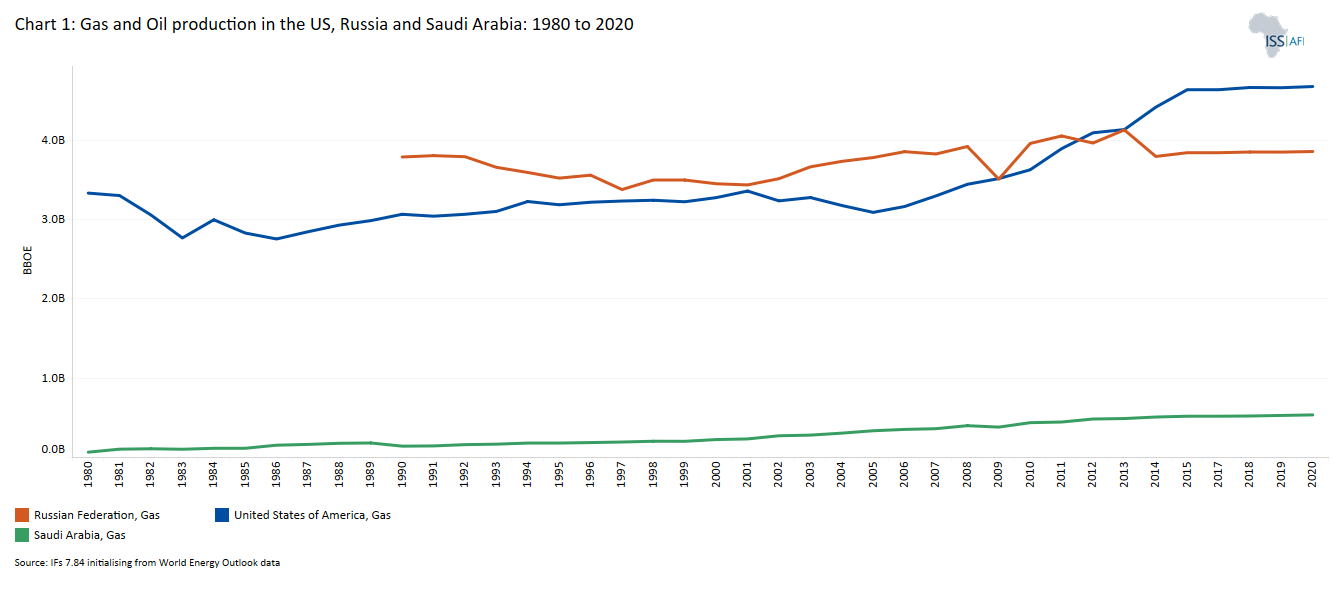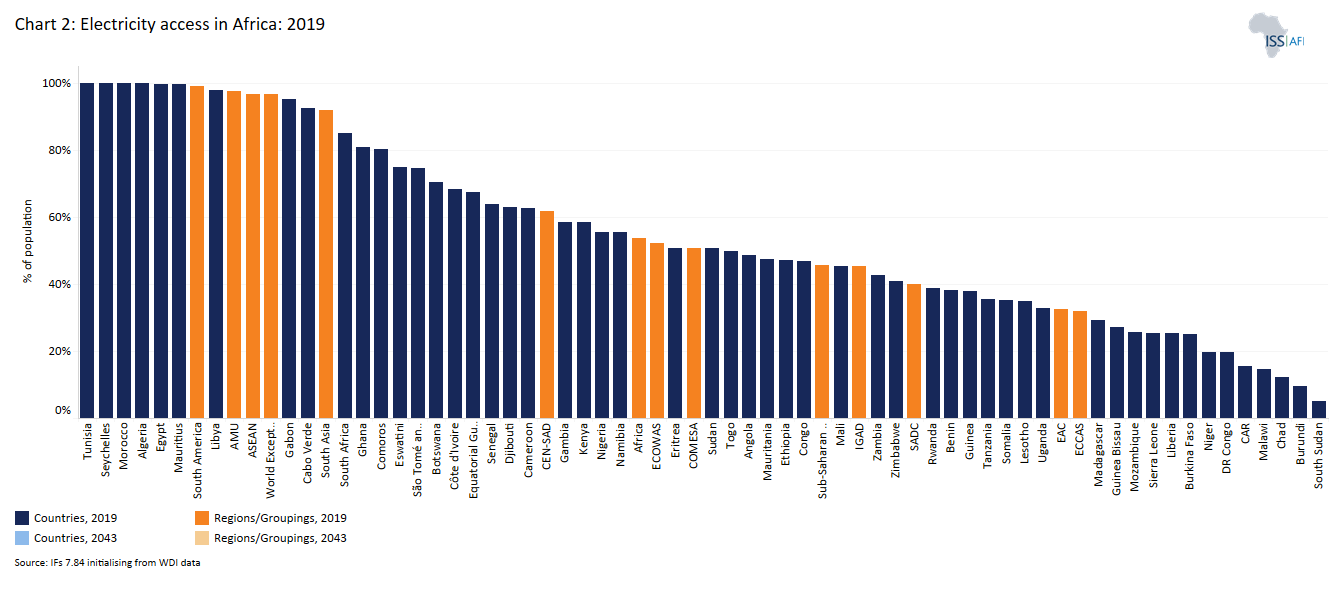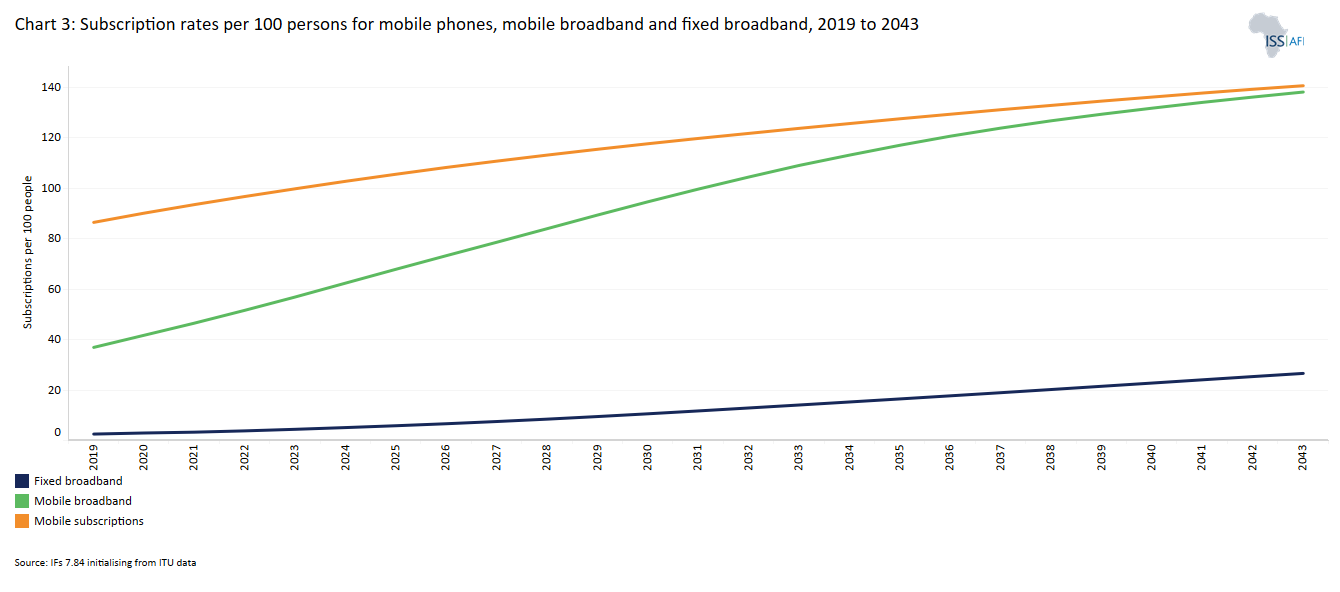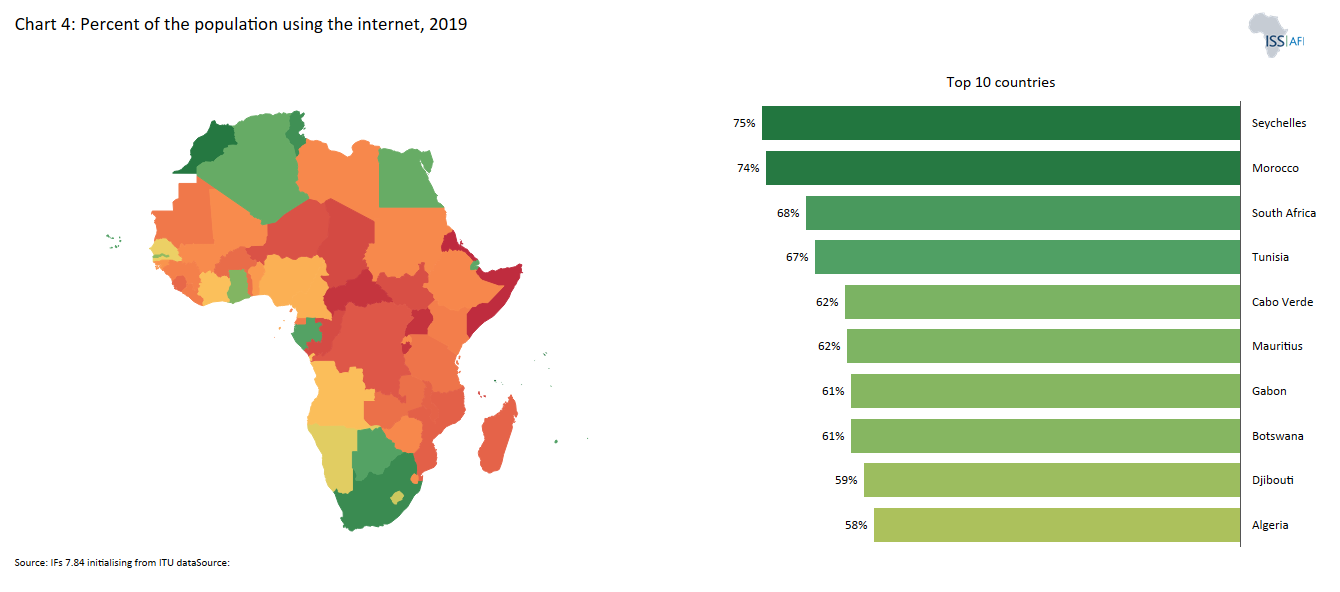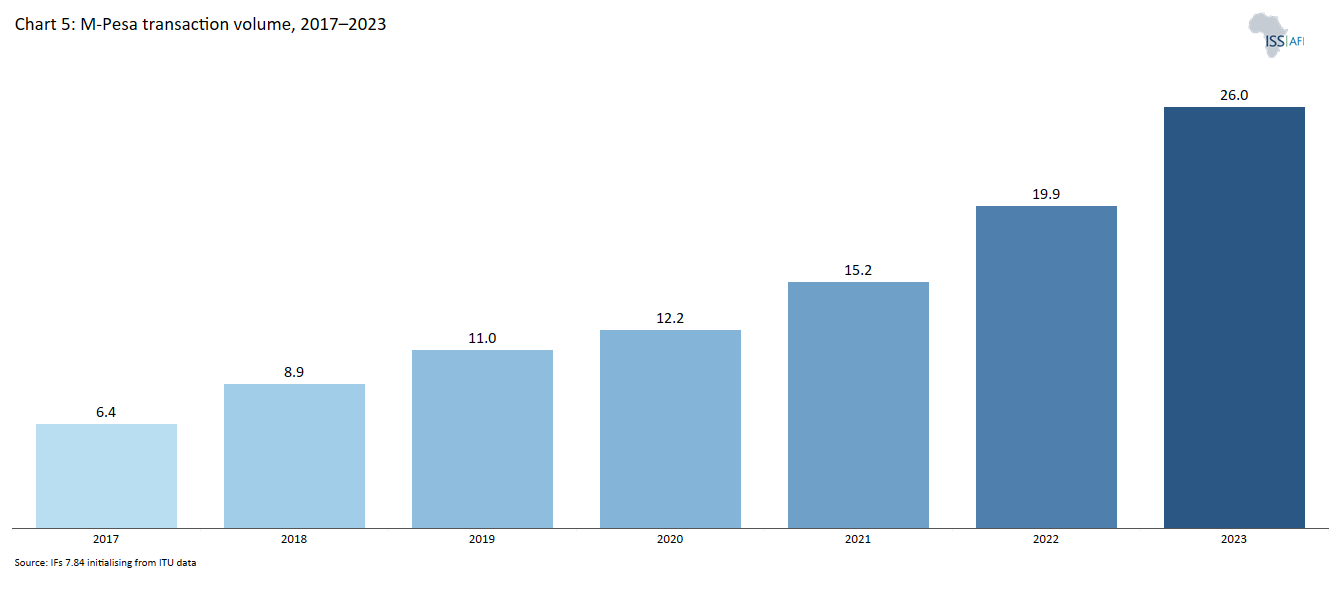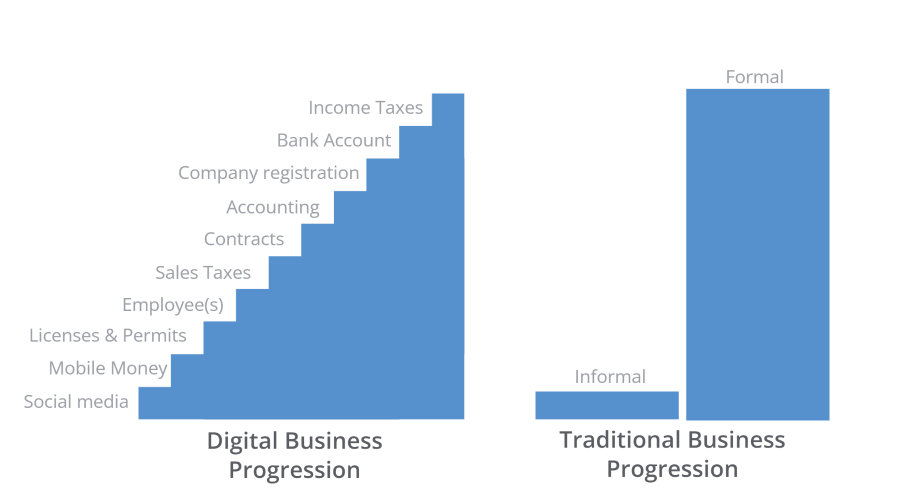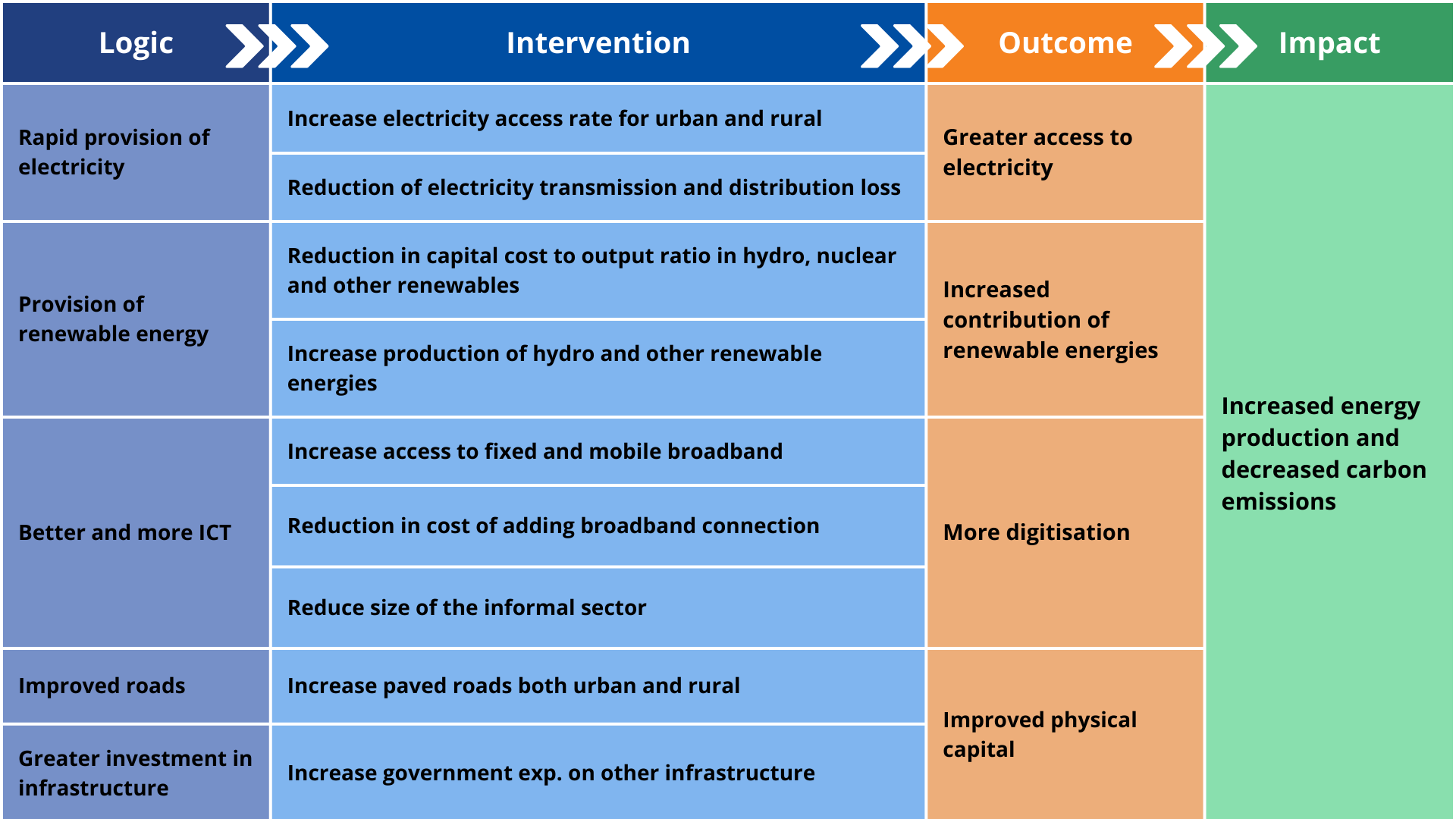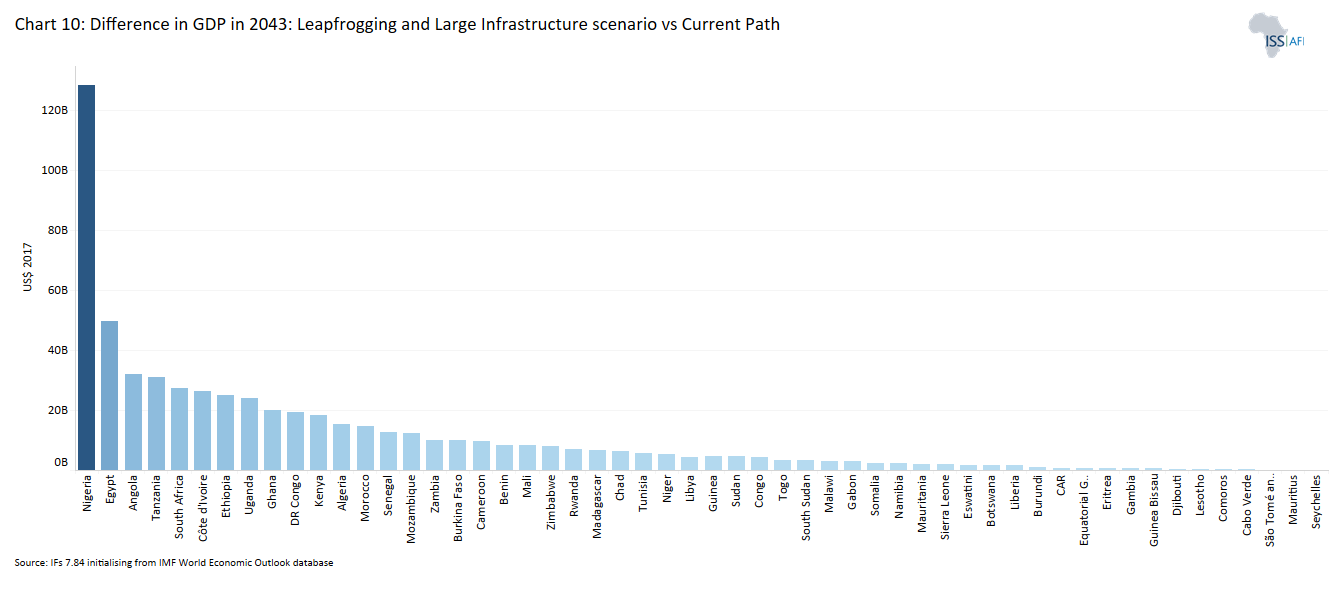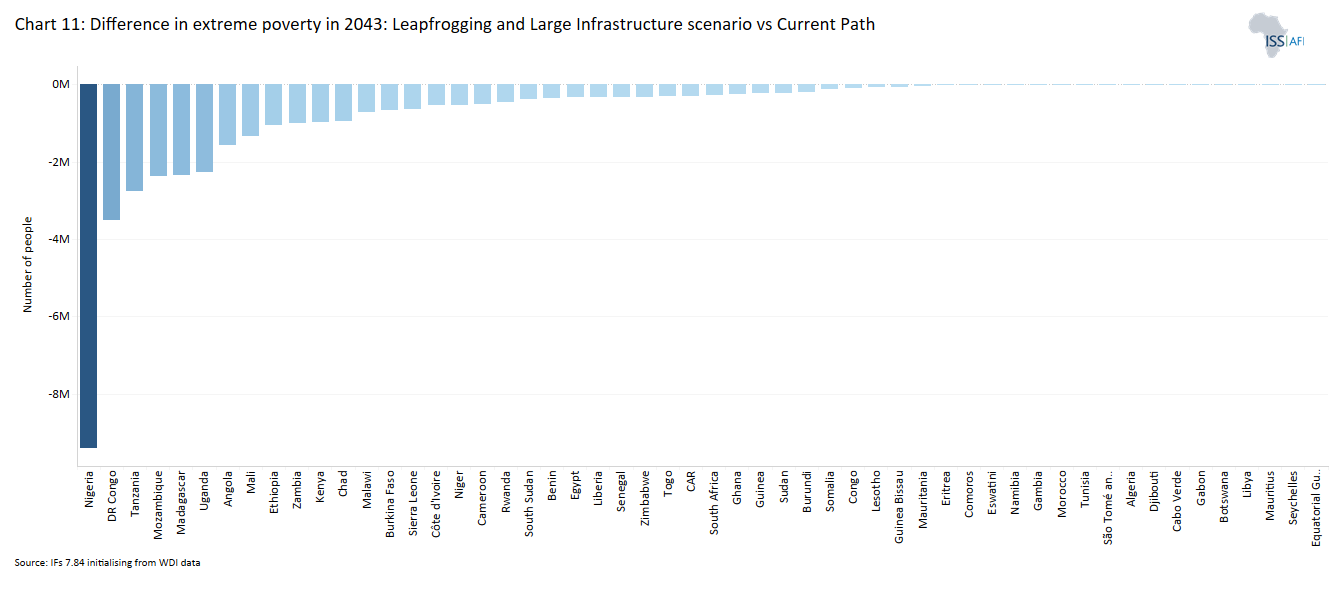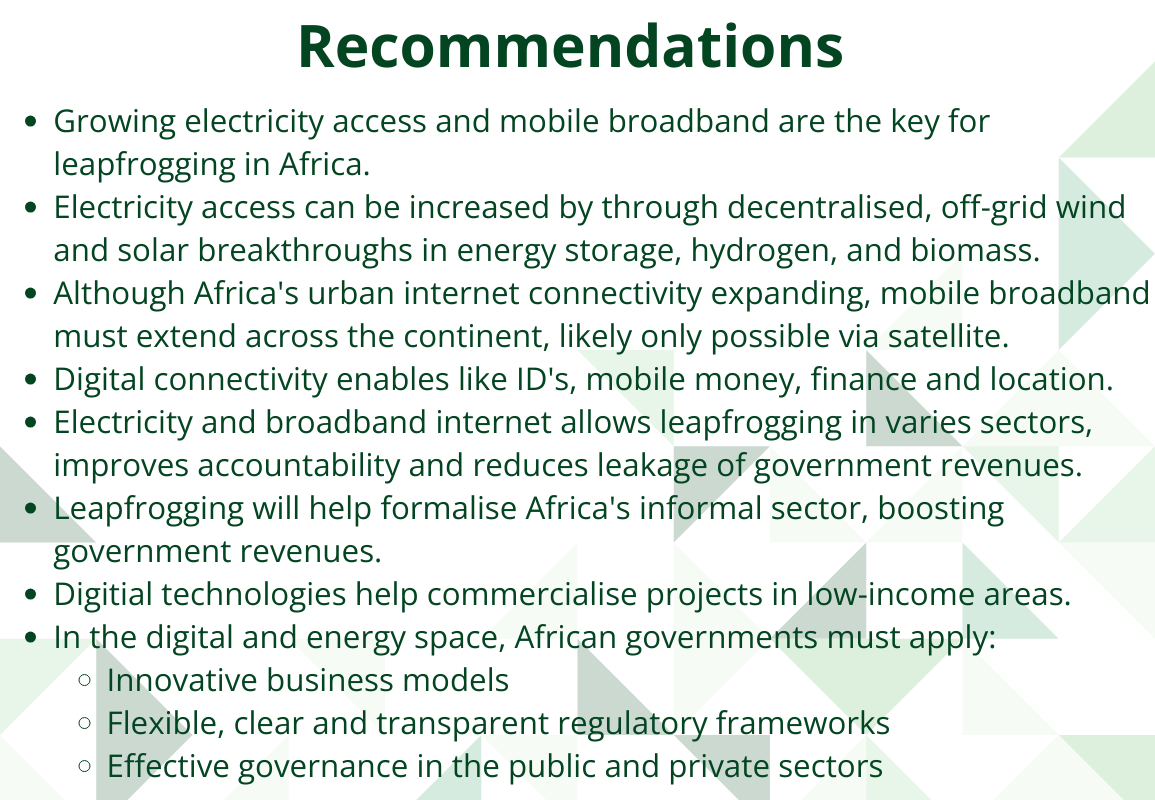 9 Leapfrogging
9 Leapfrogging
Feedback welcome
Our aim is to use the best data to inform our analysis. See our Technical page for information on the IFs forecasting platform. We appreciate your help and references for improvements via our feedback form.
This theme explores the potential of modern technology to help Africa speed up its development, including through the widespread use of decentralised renewable energy systems, artificial intelligence, and financial innovation, all of which requires expanded access to the Internet and household electricity. The subsequent Large Infrastructure and Leapfrogging scenario combines these interventions with the potential impact of investments in large infrastructure, such as paved roads, ports, railways and airports. The latter is discussed in a separate theme on Large Infrastructure, using the same combined scenario. In addition to better traditional infrastructure, such as roads, the combined effect of electricity access, access to finance and digitisation allows a more rapid formalisation of the informal sector that increases government revenues and unlocks more rapid economic growth.
Summary
- Leapfrogging can contribute to narrowing Africa’s infrastructure deficit as it advances rates of progress in many sectors.
- An example of leapfrogging and its impact is the US shale oil and gas industry and how it has shifted geopolitics.
- Africa must invest in renewables and mini-grid systems to leapfrog in energy and provide electricity for its large rural population currently without access.
- Africa has to compensate for its deficit in landlines through access to mobile phones and broadband subscriptions that will be facilitated through a number of high-speed undersea cables and satellite Internet connectivity projects.
- Mobile money is one area of digital financial innovation that Africa leads in, and its impact on livelihoods is substantial.
- Together, household electricity and internet access can improve government effectiveness and formalises Africa's large informal economy more rapidly.
- The Large Infrastructure and Leapfrogging scenario shows that investing in renewables to provide household electricity and digitalisation will improve income levels and reduce poverty significantly.
- This theme is specifically on the nature and potential impact of leapfrogging in Africa. A separate theme discusses large infrastructure. The effect of the combined impact of the Large Infrastructure and Leapfrogging scenario is discussed in both themes, and the impact on African countries and regions is presented in each geographic report.
- Africa needs concerted policy action to harnessing technology for the future
All charts for Leapfrogging
- Chart 1: Gas production in the US, Russia and Saudi Arabia, 1980–2043
- Chart 2: Electricity access in Africa, 2019 and 2043
- Chart 3: Subscription rates per 100 persons for mobile phones, mobile broadband and fixed broadband, 2019 to 2043
- Chart 4: Percent of the population using the internet, 2023
- Chart 5: M-Pesa transaction volume, 2017–2022
- Chart 6: Size of informal economy in 2019: % of GDP and % of total labour
- Chart 7: The informality staircase
- Chart 8: The Leapfrogging and Large Infrastructure scenario
- Chart 9: Difference in GDP per capita in 2043: Leapfrogging and Large Infrastructure scenario vs Current Path
- Chart 10: Difference in GDP in 2043: Leapfrogging and Large Infrastructure scenario vs Current Path
- Chart 11: Difference in extreme poverty in 2043: Leapfrogging and Large Infrastructure scenario vs Current Path
- Chart 12: Policy recommendations
Leapfrogging is a well-established phenomenon in human history. It was originally associated with the wheel, the plough, the printing press and the steam engine, each accompanied by unthinkable shifts in productivity. It is the story of technological innovation in one place that, once copied by others, allows the latecomers to leapfrog as they can sweep aside the old, outdated technologies through a process often described as creative destruction. Such as when the printing press defeated the handwriting duplicators of books, the horse-drawn carriage by the car, the mechanical typewriter by the personal computer and today, the writing of most software and much reportage by artificial intelligence (AI). Progress today is much more rapid, but all of it requires access to electricity and the Internet — both currently in short supply in Africa but gearing for rapid expansion.
What distinguishes the 21st century from previous periods is the exponential rate at which scientific knowledge is advancing and our ability to translate that knowledge into practical application. Each new generation of technology stands on the shoulders of its predecessors, and today the rate of progress from version to version is driving advancement at breakneck speed. Two examples suffice: first, the speed at which vaccines were developed for COVID-19 and now progressing to oral antiviral medicines, and second, the explosion of AI applications in the wake of the release of Chat GTP. Still, it is always important to remember that what is technologically possible is not always commercially feasible.
While much leading-edge technological progress may occur in high-income countries, uptake and social effect are often more readily seen in developing countries.
The theme on health and associated WaSH infrastructure provides an overview of the extent to which Africa trails in basic infrastructure such as potable water and waterborne sanitation. The story is, of course, much broader. Africa trails in every dimension of infrastructure, with the largest deficits being the lack of reliable electricity and transport, particularly roads, rail and suchlike. We discuss the impact of larger infrastructure projects in Africa, such as rail, airports and ports, in a separate theme (but include the impact as part of the combined Leapfrogging and Large Infrastructure scenario below).
Once a country has invested in and built an elaborate network of railway lines, pipes, wires, roads, bridges, buildings and other expensive physical infrastructure, which is characteristic of today’s developed countries, it becomes very difficult to imagine or to take the risk of investing in a different way of doing things. Every piece of existing infrastructure creates vested interests that are subsequently difficult to uproot. The result is a tendency towards ‘path dependency’, where governments and the private sector do things in a particular manner because that seems to be how things should be done and because it is difficult to get the public to change their ways and to undo sunk investments.
Consider, for example, the extent to which production and consumption subsidies have locked the world into its current carbon-intensive development pathway. According to one estimate, governments worldwide pour around half a trillion dollars annually into subsidising fossil fuels — more than triple what renewables receive.
At a sufficient scale, future technology could compete with traditional infrastructure such as road and rail. Consider, for example, bulk delivery systems via thousands of heavy-lift drones that can move directly from point to point - mass transportation systems that don’t require asphalt roads and that could replace trucks, trains, cars and buses. Already, the partnership between drone manufacturer Zipline (launched in Rwanda in 2016 doing blood deliveries) and Walmart opened up the potential for the delivery of purchases from a central logistic hub (national air regulation allowing) for on-demand deliveries of select health and wellness products with the potential to expand to general merchandise. Operating from a Walmart store, Zipline can service an 80 km radius. In 2020, Zipline was provided emergency permission in the US to fly long-range delivery drones in the US with its highly regulated air space and then later that year, also at night. In 2021, the company signed partnerships with the Cross River and Kaduna States in Nigeria and closed an agreement capable of serving 90% of Ghana’s population.
At some point, it may be possible to fly in a unit able to undertake layered fabrication (contour crafting) similar to 3D printing for rapid construction in a remote location where the unit will use local soils and compacting materials to print houses and other structures. It could source water from humidity in the air and its energy requirements from wind and thermal, then rapidly charge powerful and lightweight batteries. Or it could use that energy to produce hydrogen from water that can then be used as an energy source for heavy-duty work. The subsequent structure could be designed as a stand-alone system that limits waste and pollution, keeps products and materials in use and regenerates the natural system. These are three principles required for the transformation to a circular economy where waste is used as biomass, and it is independent of the need to be connected to bulk services such as water, electricity and waterborne sewage. The ability to remove deadly bacteria such as E. coli from water would, on its own, significantly improve the rapid treatment of large volumes of water and can be integrated into current solar water disinfection technology in countries with limited access to fresh water or where piped water connections are impractical.
The 2008 financial crisis provided a huge boost to cloud computing. A decade later, COVID-19 accelerated new technologies for vaccine development, the expansion of digital and e-commerce sectors and remote work.
The long-term impact of modern technology is likely greater independence and more choice but with the potential to deepen inequality and unemployment since it generally requires access to electricity, stable, high-speed Internet, a smartphone, tablet or computer, funds to maintain access and skilled people. The essential challenge within the dominant competitive economic and global context is harnessing technology to serve the global good.
The challenge with technology it that its contribution to improvements in productivity but does not necessarily translate into increased wages or employment. Instead it has generally increased corporate profits and return on investment to shareholders. The result is a decline in employment and stagnant or decreasing wages as employers reduce labour input costs. That trend s particularly evident when considering the impact of automation and offshoring. Instead of holding entrepreneurs and technology leaders to account, pushing production methods and innovation in a more worker-friendly direction, the association between technology, capitalism, limited government and democracy has translated into increased inequality.
Technological progress allows progress in many domains but it inevitably shifts labour requirements from a lower-productivity sector to another, higher-productivity sector, often changing employment demand and opportunities.
Recently much attention has been paid to the potential contribution of generative AI.
AI can help understand how the universe works, make better and faster diagnoses for humans, and implement automation, chatbot, adaptive intelligence, algorithm trading, and machine learning into financial processes. Similarly, generative AI’s application in data security, education, agriculture, robotics, entertainment and other aspect of life will make life easier for people. For example, the Africa Regional Data Cube (ARDC) layers 17 years of satellite imagery and Earth Observations data for five African countries (Kenya, Senegal, Sierra Leone, Tanzania and Ghana). It stacks 8 000 scenes across a time series. It makes the compressed, geocoded and analysis-ready data accessible via an online user interface, helping law enforcement identify and track illegal mining operations in Ghana.
While AI adoption has been concentrated in the Global North, effective adoption and implementation in Africa are dependent on a host of factors. They include a local workforce with the required training to develop these solutions, sufficient infrastructural capacity to handle the computationally heavy training of algorithms, representative datasets, governmental support and regulation to govern the appropriate fair use of these technologies, and independent and civil institutions and policymakers that safeguard from harmful applications and reinforce responsibility and accountability.
In time, AI may also have a globally transformative impact. An example of such impact is how the US shale oil and gas revolution reshaped the global energy market and global politics.
By 2005, US domestic oil production had declined for 35 years after its 1970 peak at 9.6 million barrels per day. The US was importing almost half of its total petroleum consumption. Then came the fracking revolution. By 2015 the US was the world’s largest gas producer. From 2008, oil production followed, and by 2018, domestic US crude oil production was running at about 11.6 million barrels per day, a little ahead of Russia, then the world’s second-largest producer.
The COVID-19 crisis of 2020/21 collapsed energy demand and the profitability of many shale gas and oil operators. With insufficient oil and gas, storage prices plummeted until Russia invaded Ukraine, and Europe sought alternative supplies of gas and oil, sending prices skyrocketing.
Whereas the shale gas revolution in the US is based on a large oil and gas industrial ecosystem that is still difficult to replicate elsewhere, rapid technological advances, such as those linked to renewable energy sources, require a much smaller technology footprint. They will have a significant impact on Africa.
Renewables can revolutionise electricity access in Africa in a way not dissimilar to fracking in the US and by empowering locals rather than those further away. It is coming to Africa in three forms, namely:
- distributed local systems using renewables, mostly solar, wind and geothermal,
- the improvement and distributed installation of electricity storage systems, such as new types of batteries, and
- new technologies such as hydrogen, waste-to-biomass conversion and eventually nuclear fission.
In much of Africa, electricity is often an unaffordable luxury, even where connections exist. The average retail price for electricity in Africa varies hugely. It can be as high as US$4.90/kWh in Liberia due to the high cost of running a backup generator during regular power shortages or as little as US$0.24 in Ethiopia.
Electricity consumption per person in large African countries (for instance, Ethiopia, Kenya and Nigeria) is less than one-tenth of that in Brazil or China. In poorer countries like Mali, a typical household uses less electricity in a year than someone in London uses to boil a kettle each day.
High electricity prices and intermittent supply mean that many African households don’t access electricity from a central system. Those homes with an electricity connection often find the supply inconsistent and expensive. Lack of electricity also acts as a strong disincentive to private investment, especially in sectors where a dependable supply is crucial such as cold storage in the distribution of food from farm to consumer or minerals beneficiation and manufacturing. As shown in Chart 2, in 2019, only about 54% of Africa’s population had access to electricity; this is in contrast to about 92% in South Asia and over 98% in South America, the other two developing regions that we benchmark against. The rapid electrification of the African continent would improve human development and economic prospects. On the Current Path forecast, more than a quarter of Africans would still not have electricity access by 2043.
Among its obvious economic benefits, affordable, reliable electricity eliminates the need to use traditional fuels inside the home for cooking, heating and lighting, thereby reducing the potential for respiratory ailments and allowing children to study longer at night. It would speed up education, improve health and allow for farming and micro-manufacturing.
Off-grid solutions could reach consumers in rural areas without the hefty expense of large coal, oil or gas-powered power plants linked to the hinterland through massive transmission lines and complex distribution systems. In sub-Saharan Africa, almost 60% of the population lives in rural areas. Rural electricity access in Central Africa was roughly 7% in 2019, in West Africa, it was 26%, and slightly better for East and Southern Africa. The average for sub-Saharan Africa is about 26%, whereas for highly urbanised and developed North Africa, it is at 97%.
In this context, mini-grids powered by the sun and wind independent of the larger national grid could provide many opportunities. These technologies can also be deployed much more rapidly than traditional electrification methods.
Globally, Bangladesh and Laos are two countries widely cited as having expanded electricity access particularly rapidly. Bangladesh increased access by about 50 percentage points in roughly 20 years, while Laos increased it by approximately 60 percentage points in 25 years. Kenya has made even more rapid progress.
Remotely deployed renewables are already bringing about major shifts in how Africa will provide electricity to its people. What could prove to be transformative, allowing cooking, space heating and energy-intensive economic activity is a breakthrough in energy storage technology, particularly inexpensive, fast-charging high-capacity batteries for electric vehicles and grid storage such as with anode-free sodium solid-state battery technology. Currently, electricity grids that include a large component of renewables have to allow large redundancies (surplus capacity) to meet demand on a guaranteed basis (so-called base-load capacity).
Among other things, distributed energy from renewables will facilitate the rapid expansion of communications and the Internet. These are important enablers for leapfrogging across dimensions as diverse as education and infrastructure.
All information and communication technologies (ICT) improvements impact positively on the economy, from more fixed telephones and more mobile phones to better Internet use, fixed broadband and, most positively, access to always-on mobile broadband.
Mobile technology prices dropped by about 40% globally and nearly 60% in Africa in the last five years of the 20th century, as did the demand for costly fixed telephone lines. This led to rapid improvements in the proportion of the population with access to a mobile phone without much additional cost to the consumer. It also allowed governments to focus on other priorities.
In 2000, Nigeria’s 122 million inhabitants had little more than 553 000 fixed-line phone connections. This number has roughly doubled since taking the ratio of fixed lines to 100 people to about 0.6. But mobile phone subscriptions have gone through the roof, now at 91 per 100 people. If these are smartphones with mobile broadband, users can access digital education and online advisory services in the health and agricultural sectors. Leapfrogging means the democratisation of knowledge.
Chart 3 compares the rate of subscriptions per 100 persons for fixed broadband, mobile broadband and mobile phone subscriptions for African countries and other regions. It shows the extent to which mobile phone subscription rates in Africa have increased rapidly while that for mobile broadband is also improving steeply. While mobile Internet access is expanding rapidly, businesses generally require the speed and reliability of fibre and other broadband lines — areas in which Africa trails significantly but with the potential for rapid increases as household electricity access and internet access through satellites and other large-area coverage expands.
Globally, Africa has the lowest internet penetration rate, at only 33%, although it is a significant increase from only 7.6% in 2009.
Young Africans in urban areas are well connected, with about 80% owning their mobile phone and most using it daily. While more than half of households in Morocco, Mauritius, South Africa and Seychelles have Internet access at home, in Liberia, the DR Congo, Congo, Guinea Bissau and Eritrea, that number is less than 3%. Sub-Saharan Africa still trails the rest of the world in mobile subscriptions, but the gap is much narrower now than when fixed-line technology dominated.
Compared to internet usage, mobile phone penetration is much higher. Although only about half of Africans own a mobile phone, another 15–20% do not have access to one, making the mobile phone access rate about 65–70%. The paradox of poverty is that more Africans have access to mobile phones than anything else, including electricity or improved sanitation.
The result is that in this domain, mobile telephony, many in Africa and Asia, were able to partially leapfrog expensive and time-consuming technologies and to achieve a degree of catching up with other parts of the world. Moreover, much of the mobile network in Africa was largely built by the private sector, illustrating the potential of markets here to attract foreign investment under the right conditions. The continuation of these investments will shortly enable mobile phone subscription and Internet access rates in sub-Saharan Africa that would have seemed unthinkable a few decades earlier.
Broadband, or high-speed, always-on Internet connectivity, is a powerful general-purpose technology, although it requires a certain penetration threshold before significant impact is discernible. Thereafter, it drives widespread changes in the IT sector, enabling services such as cloud computing and AI. Furthermore, there is no clear finding about diminishing returns at higher levels as it influences innovation across many other sectors, including health, transport and government. Studies differ, but generally, with a 2016 background paper for the World Development Report reporting that a 10% increase in national broadband penetration results in an increase of 0.6 to 2.8% of GDP. A recent World Bank blog summarized findings from a range of studies that internet access likely drives economic development on both the supply side and the demand side of an economy since digital connectivity directly affects productivity and access to markets. The productivity gains of the internet vary considerably across different contexts, however, as does its role in building skills and students’ academic achievements.
Increased mobile phone penetration guarantees further innovation and additional investment, currently unavailable in many rural areas. Given the potential of Africa’s large population as the last remaining unconnected market, large IT companies are all trying to achieve a first-mover advantage. Google was one of the first to try with Project Loon, which sent a fleet of balloons into the stratosphere to beam Internet service to people below but abandoned that effort two years later. Other tech giants such as SpaceX, Facebook and various SoftBank startups are trying different approaches involving satellites, drones and blimps, respectively.
Then there is the 37 000 km undersea cable that Facebook and a host of partners are building around Africa to connect 35 countries in Africa, the Middle East and Europe. The project, dubbed 2Africa, will provide nearly three times the total network capacity of the subsea cables currently serving Africa and is scheduled for completion in 2024. That effort is in addition to a project by Google, Facebook, MTN and China Mobile that recently completed an underwater cable called Equiano, connecting North, West, Central and Southern Africa with Europe.
Perhaps the most exciting projects were announced by the telecommunications firm AST & Science and more recently Starlink/Jumia. The former is a partnership with Vodafone, through which AST & Science plan to establish a space-based mobile network (AST SpaceMobile) to connect directly to 4G and 5G smartphones without needing specialised hardware such as ground antenna systems. The first phase of the project aims to transform mobile network coverage north and south of the equator, where Vodafone will integrate its technology into existing brands in the DR Congo, Ghana, Mozambique, Kenya and Tanzania. The second partnership, between Space Exploration Technologies Corp Starlink and e-commerce company Jumia Technologies AG, started in Nigeria to sell terminals in areas that lack formal addresses and city mapping, linking the portable terminals capable of connecting to Starlinks network of thousands of small satellites low-earth orbit satellites. Jumia plans to eventually sell Starlink's products in the 11 African countries where it operates.
Internet access in and to Africa is set to explode.
5G networks will have almost no delay, be at least a hundred times faster than 4G networks and be able to serve a hundred times more devices within a square kilometre. Together with AI it will allow driverless cars to make decisions through the cloud, robots to become more common and doctors to perform more complex operations remotely as precision transforms healthcare, enabling health systems to provide more targeted and accurate diagnoses and treatments.
Moving to 5G will, however, require a step change in infrastructure roll-out and much more rapid technological shifts. A 2020 GSMA Mobile Economy report showed that 3G will remain the most dominant network (58%) for the 1.05 billion mobile connections projected in Africa by 2025. ‘The focus in the near term for operators and other stakeholders is to increase 4G uptake,’ the report states. Indeed, 4G connections are expected to account for only 27% of mobile connections by 2025 — up from 4% today.
The road ahead is a long one, but providing household electricity and then Internet access to all of Africa could unlock rapid progress, including in the financial sector.
It is notoriously difficult to obtain credit in Africa, even for qualified borrowers, partly because currencies and markets are vulnerable and also because many institutions lack the capacity or resources to run large-scale lending operations to many poor users. Mobile telephony allows people who formerly had no access to bank accounts to transfer and withdraw money, including peer-to-peer payments, and take out loans or insurance. Today, mobile money has become a significant driver of social inclusion. Much of it started with M-Pesa (pesa means money in Kiswahili, widely spoken in East Africa).
In 2020, sub-Saharan Africa was responsible for almost half of mobile money activity in the world, with a transaction value of US$490 billion.
By the end of 2022, M-Pesa had 50 million customers across seven African countries and processed almost 20 billion individual transactions annually, as shown in Chart 5. Its success has created an entirely mobile banking industry. In Uganda, one of many countries to seize the subsequent opportunities, the digitisation of utility services such as water and sanitation has followed, among others, benefiting from the rapid growth in mobile access.
Mobile money and the ability of digital solutions to coordinate a range of public, private and civic stakeholders are driving inclusion and enabling informal sector workers to climb up the formality stairway to which we turn below. For example, Uganda’s National Water and Sewerage Commission Services have digitised their utilities, including water, sanitation and electricity. In Kampala, 94% of the city does not have waterborne sewage and relies upon pit latrines, septic tanks and a bucket system. Today, the Kampala city platform combines a call centre with a mobile application that allows for the payment and scheduling of services. Pay-as-you-go solar is also expanding.
Internet-enabled technologies have also reduced consumption poverty and increased incomes. A 2016 study from the Massachusetts Institute of Technology estimates that M-Pesa has lifted nearly 200 000 households out of poverty since its inception, and that number would have increased substantially thereafter. The improvements were more significant for female headed-households and helped about 185 000 people move from agriculture to some other business venture. Access to mobile money helped borrowers navigate uncertainties caused by drought, adverse health conditions or other unforeseen events.[1A Leke, M Chironga and G Desvaux, Africa’s business revolution: How to succeed in the world’s next big growth market, Brighton: Harvard Business School Press, 2018.]
The mobile money service also drove an increase in savings rates of more than 20% because a more secure method of storing money instils confidence in people that the future is worth investing in.[2A Leke, M Chironga and G Desvaux, Africa’s business revolution: How to succeed in the world’s next big growth market, Brighton: Harvard Business School Press, 2018.]
While national mobile payment systems are seeing rapid progress, cross-border payments are often slow, expensive, opaque, cumbersome and inaccessible to many. Although technology has ushered in a new era of innovation in payments, linking the plumbing up between countries — by directly linking existing payment systems across borders — is still at an early stage. In 2021, IMF Managing Director Kristalina Georgieva pointed to the importance of getting the incentives right, using the regional payments system of the Southern African Development Community (SADC) as an example. The platform now includes 74 commercial and eight central banks across 15 countries.
‘Imagine,’ Ms Georgieva noted, ‘a virtual marketplace where payment providers across countries can meet to transact according to common rules and procedures and a common technical infrastructure. Or a platform that allows households and firms to send central bank digital currencies directly to each other, immediately and without going through multiple costly intermediaries.’ There are, of course, significant risks given the ‘tension between open and interoperable cross-border payments — a technical objective — and countries’ policy objectives to manage capital flows, limit volatility, and retain control over monetary policy and exchange rate regimes.’ That, she mentioned, underlines the importance of macro-financial stability to underpin such cross-border systems. Most associated challenges will be overcome as part of implementing the African Continental Free Trade Area , examined separately.
Beyond their direct impact on economic growth and prosperity, Internet access and mobile phones have also become tools for social transformation. For example, Public Expenditure Tracking Surveys (PETS) have been widely adopted as a tool for tracking the flow of resources for a particular good or service to asses whether the funds reach the intended beneficiaries. For example, a 1996 PETS survey of public schools in Uganda showed a leakage rate of 87% in Uganda’s education spending, which fell to 20% after the publication of the findings: in Tanzania, a 1997 PETS found 57% leakage in education and 41% in health spending. In Ghana, a 2000 PETS found 50% leakage in education and 80% in health. Digitization can potentially reduce corruption and leakages in program delivery.
However, mobile money also serves various nefarious activities. Following the 2021 terror attacks in Palma, Northern Mozambique, during which the terrorists from Ahlu-Sunnah wal Jama’a (ASWJ), supported by Islamic State in Mozambique, managed to rob and destroy two banks, the Southern African Development Community (SADC) established a technical mission to assess the nature and capabilities of the group ahead of a regional military intervention. One of the preliminary findings of the mission was that ASWJ receives funding through mobile money transfer platforms like M-Pesa, M-Kesh, and e-Mola from sympathetic individuals and private organisations from various countries across the region. Currently, mobile money transfer services generally fall outside the purview of national financial regulations ensuring the continuation of poor monitoring and oversight.
The impact of Internet access and mobile phone technology on elections, government accountability and potentially the spread of democracy has been profound. For example, after no candidate received the required 50% in the first round of presidential elections in Ghana on 7 December, 2008, in the runoff between former Foreign Minister Nana Akufo-Addo and former Vice-President John Atta Mills three weeks later, fewer than 31 000 votes separated the winner from the loser (a margin of less than 0.4%, with 73% of registered voters voting). Despite a history of coups and social turbulence in Ghana, the country and the region accepted Mills’ victory. The tradition was maintained when, in December 2020, Nana Akufo-Addo won with 51% of the valid votes.
The reason for this was that civil society had been able to harness mobile phones and the Internet to place thousands of trained election monitors armed with mobile phones and an SMS-based coding system to check, report and tabulate results. In this manner, a parallel civil society system could verify official tallies and ensure a credible result.[3H Dugmore, The impact of new media on recent sub-Saharan Africa elections (and African Democracy in general), PowerPoint presentation shared with the author on 26 November 2010. Dugmore is MTN chair of media and mobile communications at the School of Journalism and Media Studies at Rhodes University, South Africa.]
This pattern has been emulated in various forms across the continent, reducing the ability of incumbents and special interest groups to manipulate and distort results to their advantage — although not always successfully so.
The theme on jobs/employment deals with, at some length, the relationship between the formal and informal sectors and examines the potential benefits that the more rapid formalisation of the informal sector would have on Africa’s economic and developmental prospects.
For the International Labour Organization (ILO), the transition to formality is ‘a central goal in national employment policies.’ All things being equal, reducing the size of the informal sector has distinct advantages as long as it does not detract from economic activism, is carefully managed, incentivises employment and does not stunt growth. The informal sector is important in providing employment and income for millions of poor Africans and will continue for many future decades.
Chart 6 presents the IFs estimate of the portion of GDP considered informal and the portion of the informal labour as a portion of the total labour force globally in each African country and group. Note that the size of the informal sector within IFs is often a modelled estimate given data limitations.
Internet access, mobile phones, and digitisation allow African governments to break down the barriers between the formal and the informal sectors and to facilitate the incremental move from the one to the other. Normally, as GDP per capita increases, the size of the informal sector decreases. Modern technology allows the crowding in of the informal sector at lower income levels, as shown in Chart 7 - and in contrast to the sharp step change from informal to formal, also depicted.
The effect of digitisation is to lower the entry point for private capital in poor areas.
The first step towards formalisation is the provision of digital ID systems. According to the World Bank, Africa is home to roughly half the estimated one billion people who cannot prove their identities. Nearly every African country with a stable government now has active biometric ID programmes in place or underway, according to ID4Africa, an NGO advocating identity-for-all. Biometric IDs in South Africa and Nigeria are among the most developed.
The provision of digital identification unlocks access to banking, government benefits, education and other critical services. In the words of a recent study on digital ID and payment, digital technology enables ‘the precise identification of all parties to an interaction; low-cost communications; and accurate, accountable, and convenient payment processes.’ A study of seven focus countries (Brazil, China, Ethiopia, India, Nigeria, the UK and the US) by McKinsey found that extending full digital ID coverage to citizens could unlock economic value equivalent to 3–13% of GDP in 2030 — if the digital ID programme enables multiple high-value use cases and attains high levels of usage. According to the UN Economic Commission for Africa (UNECA), countries implementing digital identity could unlock value equivalent to 3 to 7 per cent of GDP on the continent by 2030.
In its report on ‘Digital solutions for the urban poor’ that draws on the work of Ng’weno and Porteous, among others, the GSMA notes that pay-as-you-go (PAYG) models, as one example, allow low-income customers to make small incremental payments towards otherwise unaffordable goods. This has demonstrated excellent results when applied to rural electrification and is now also unlocking a range of urban services such as water, clean cooking gas, and sanitation. PAYG leverages the ubiquity of mobile money to make goods and services more affordable in low-income communities, particularly in urban areas with a higher density of mobile money agents than rural areas and where populations are more likely than their rural counterparts to use mobile Internet.
The associated policies need to be done incrementally and carefully. Zimbabwe, which has seen its formal economy collapse through bad policy, mismanagement and corruption, introduced a large 2% transfer tax in 2019 that proved hugely unpopular, followed by Cameroon at a much lower rate of 0.2%. From 1 May 2022, Ghana introduced an e-levy of 1.5% to electronic transactions above US$13, but only after the debate in parliament had come to blows, with opposition members of parliament staging a walkout.
Formalisation is positive because workers in the formal sector in African countries are four to five times more productive than those in the informal sector. Using the IFs forecasting platform, we find that the size of Ghana’s economy increases by roughly US$1 billion (in PPP) over ten years for every 1% decrease in the size of the informal sector as a portion of GDP. And the benefits keep on growing after that. In other words, if Ghana could use digitisation to draw people into the formal sector and, hence, reduce the size of the informal economy as a portion of GDP by five percentage points from 2023 to 2033, its economy would be US$5 billion larger in 2033. Because the size of the informal labour as a proportion of total labour is about 22 percentage points higher than the GDP share, the intervention reduces the size of informal labour more rapidly.
A larger economy translates into higher average incomes. The result of a one percentage point decline in the informal sector in Ghana is an increase of US$31 GDP per capita above the Current Path forecast by 2033. That is an enormous improvement. Other livelihood improvements that follow are decreases in poverty and inequality.
Therefore, modern technology provides the opportunity to formalise additional parts of the informal sector incrementally.
In the following scenario, we include formalisation as a powerful component of leapfrogging.
This section explains the structure of the Leapfrogging and Large Infrastructure scenario, which could set Africa on a more positive human development trajectory than the Current Path forecast. The same scenario is used in the theme on Large Infrastructure. The scenario is presented in Chart 8. The reader is also reminded to visit the scenario section in the Large Infrastructure theme and that other scenarios include sector-specific infrastructure, for example:
- The Agriculture scenario includes interventions on irrigation, groundwater extraction, rural road access and irrigation.
- The Demographics, Health and WaSH scenario include interventions in safe water and sanitation infrastructure.
The first set of interventions in the Leapfrogging and Large Infrastructure scenario emulates a more rapid transition to an energy solution that includes more solar and wind and better energy storage that is then used in intelligent power systems in decentralised micro, mini and off-grid solutions. To model such a scenario, we increase renewable energy production, reduce the capital cost-to-output ratio for renewables, and reduce electricity loss in transmission. Specifically, energy production has been improved by 20%, cost to output reduced by 20% and electricity transmission loss reduced by 10% to 20% at different income levels. All of these mean more rapid technological progress than the Current Path forecast within the IFs forecasting platform.
The next step is to improve rural and urban electricity access. The size of the interventions ranges from an additional 15–27% rural electricity access by 2033 above the Current Path forecast and an additional 3–8% in urban areas. The impact is that, on average, electricity access in low-income African countries improves by 10 percentage points above the Current Path forecast by 2043, by six percentage points for lower-middle-income countries and by seven percentage points for Africa’s upper-middle-income countries, with large country-to-country differences.
By 2043, 81% of Africans have access to electricity in the Large Infrastructure and Leapfrogging scenario compared to 73% on the Current Path forecast. Instead of 610 million Africans without electricity connections on the Current Path forecast, the 2043 number is 430 million. By 2043, the Leapfrogging and Large Infrastructure scenario realises an improvement of 819 million barrels of oil equivalent (BBOE) from other renewables (wind and solar), a significant 54% improvement on the Current Path forecast. But, because renewable production comes off a low base, it modestly improves its contribution to energy production by six percentage points to 23%. The modest result needs to be seen within the context of an African economy that is seven percentage points larger in the Large Infrastructure and Leapfrogging scenario compared to the Current Path forecast.
The second set of interventions includes a faster roll-out of mobile broadband and general improvement in ICT. Despite rapid uptake, Africa trails significantly behind others in this regard. We improve fixed broadband by 50% to 2033, Internet use by 20% and mobile broadband by 300%. The impact is that, on average, fixed broadband access increases to 37 instead of 27 persons per 100 by 2043, a difference equivalent to 220 million additional people. Because mobile broadband increases rapidly in the Current Path forecast, the Leapfrogging and Large Infrastructure scenario increases more rapidly to 2030 but eventually only realises an improvement of three additional persons per 100 people, a difference of 70 million people, by 2043. As a result, the contribution of the ICT sector to African economies increases by roughly US$46 billion in 2043 above the Current Path forecast (equivalent to about 0.1 percentage point of GDP). Nevertheless, even then, the ICT sector will constitute less than 7% of the African economy.
In a third and final set of interventions, we emulate the impact that digitisation and modern technology could have on more rapidly formalising the informal sector. The intervention consists of reducing the informal sector share of GDP multiplier by 3–14% depending upon income level and reducing the informal labour share multiplier by 2%. The impact is that by 2043, the size of Africa’s informal sector, as a per cent of GDP, is 2.6 percentage points smaller. The reduction in the total labour force employed in the informal sector is modest (two percentage points below the Current Path) by 2043.
The Leapfrogging and Large Infrastructure scenario illustrates the impact of African governments taking maximum benefit from the potential of new technologies and the digital economy to extract development benefits for their societies.
The impact of the Leapfrogging and Large Infrastructure scenario is that the average growth rate for Africa from 2023 to 2043 improves by 0.24 percentage points. This results in an African economy that is US$602 billion larger in 2043 than in the Current Path forecast. Consequently, there is a strong increase in GDP per capita, reflected in Chart 9.
All countries experience an increase in the size of their economies. Chart 10 presents the difference in the size of each African economy in 2043 in the Leapfrogging and Large Infrastructure scenario compared to the Current Path. The user can choose between absolute difference and per cent increase in the size of the economy
Four countries experience an increase in the size of their economy of more than 15% namely Uganda, Madagascar, Central African Republic and Burundi. Fifteen other countries experience a more than 10% increase in their economy from Leapfrogging and Large Infrastructure scenario; 27 other countries experience between five and 10 percentage point increases.
Because the size of the economies being compared is quite different, the actual dollar numbers are much more impressive. For example, the Nigerian economy will, in 2043, be US$126 billion bigger than in the Current Path — the largest increase in absolute terms — followed by Egypt at US$52 billion. The corresponding figures for Angola and South Africa, other large economies, are US$32 billion and US$29 billion, respectively.
Leapfrogging is not only about improving growth, infrastructure and income. The Leapfrogging and Large Infrastructure scenario will also reduce poverty in Africa. Madagascar, a low-income country, will benefit the most, reducing its 2043 poverty headcount (using the US$1.90 benchmark) by five percentage points below the Current Path. Sierra Leone, a lower-middle-income country, will reduce its poverty headcount (also using the US$1.90 benchmark) by 4.8 percentage points below the Current Path. The impact of countries with low poverty rates is minimal or negative.
The Large Infrastructure theme contains additional analysis on the scenario's impact related to various other measures.
This theme started by examining the notion of leapfrogging and then presented examples of how different technologies offer opportunities for Africa to begin closing the gap with developed countries. It noted that modern technology may even prevent the requirement for traditional infrastructure, such as large electricity grids or roads. It has therefore examined both the notion of stage-skipping, where a country bypasses conventional stages of development, such as using mobile phone connections instead of landlines. It also explored the potential of forging an alternative path of technological development involving emerging technologies with new benefits and new opportunities (path-creating), such as using renewables instead of carbon fuels for energy.
Much attention has been placed on the potential and impact of AI, which is set to change the productive structures of many economies. The challenge with Africa is twofold, write Daren Acemoglu and Simon Johnson[4Daren Acemoglu & Simon Johnson, Power and Progress: Our Thousand-year Struggle over Technology and Prosperity, Basic Books, London, 2023 p 336]. First, ‘rather than creating jobs and opportunities for the majority of the population in poor and middle-income countries, the current path of AI is raising the demand for capital, highly skilled production workers, and even higher-skilled services, such as from management-consulting and tech companies.’ The second is that digital tools are used for massive data collection and processing—potent tools in both autocratic governments and private companies interested in surveillance and the dependence upon big data for social control and their business models, respectively. The results are in full display in China and in oil-rich autocracies in the Middle East.
Many areas of leapfrogging were not examined in this theme but in separate themes, such as those dealing with health and education. General improvements in medical science could curb malaria, HIV infections, respiratory infections, tuberculosis and other diseases that currently ravage large populations in Africa, modelled in the Health/WaSH scenario. The manufacturing theme explores the potential to use digital technology as an effective means towards targeted cash transfers to their citizens.
Whichever example we wish to use, technological innovation and leapfrogging will fundamentally shape development on the African continent, particularly if governments decide to pursue those options intentionally. African leaders need to seize the opportunities offered by modern technology and build the productive structures of their economies to unlock rapid growth, alleviate poverty and improve incomes sustainably. Measures to integrate the informal economy into the formal sector are essential, and this theme is enthusiastic about the potential that modern technology offers to simplify and ease the business regulatory framework, design and implement an uncomplicated and progressive tax regime and appropriate labour market regulation that would provide greater employee social security and stability. The emphasis must be on progressive employment programs focusing on occupational health and safety aimed at helping the informal sector transition to formal employment.
Writing for the Center for Strategic and International Studies, Erol Yayboke offers an essential insight in this vein: ‘Enthusiasm for taking advantage of leapfrog opportunities,’ he cautions, ‘should not distract developing nations from what should be their overarching goal: becoming producers in their own right, rather than simply consumers of technologies and services developed elsewhere.’ Leapfrogging is not merely copying high technology from others. It is a sequential process of learning by latecomers, building skills in product design and acquiring the capability to create new products — particularly to overcome the extent to which the developed world locks in patent and intellectual property rights to their exclusive use. After all, the real drivers of economic growth are innovation, new knowledge and new technology.
Digitisation and the Fourth Industrial Revolution will allow Africa to leapfrog in crucial areas — for instance, energy supply and some aspects of infrastructure and health, among others — but could also leave the continent trailing further behind. Where technological adaptation is inevitable, its impact will be magnified by efficient and open markets, clear and transparent regulatory frameworks, effective public and private governance, and the ability to leapfrog established systems. Ironically, the threat to leapfrogging may largely come from African governments themselves since countries such as Uganda, Tanzania, Eswatini, Zimbabwe and Ethiopia shut down access, particularly ahead of elections, worried that social media platforms could be used to challenge the party in power. Others, such as Eritrea, simply do not allow internet access.
A strong focus on technology can provide leapfrogging opportunities for low- and middle-income countries. Still, governments must not lose sight of ‘traditional’ developmental issues, such as governance, infrastructure and skills. According to Saadia Zahidi:
With opportunities for economic leapfrogging, diffusion of innovative ideas across borders and new forms of value creation, the Fourth Industrial Revolution can level the playing field for all economies. But technology is not a silver bullet on its own. Countries must invest in people and institutions to deliver on the promise of technology.
Therefore, the primary challenge that Africans and international financial institutions face is twofold. First is the ability of African governments to apply innovative business models and flexible regulatory approaches to growth — an agile approach to regulation, perhaps most evident in Rwanda, where the country has provided 4G mobile phone coverage to 95% of its (admittedly small) territory within just four years and established a domestic drone start-up to establish itself as an international supplier of delivery services. The second challenge is for governing elites in poor countries to lever the policy space to carve out space for industrialisation policies that do not run foul of the dictates of the World Trade Organization.
Levering the potential of leapfrogging is therefore not merely asking regulators to get out of the way but about flexibility and a willingness to embrace experimentation, reflecting ‘the bottom-up nature of most instances of leapfrog development and the need for policymakers to proactively engage with entrepreneurs and technologists to ensure that growth in new technologies isn’t stunted by regulations meant for a different age.’ It is developing and applying a deliberate industrial strategy aimed at this exclusive goal, not unfettered free markets or laissez-faire economic policies. Erik Reinert cautions poor countries to learn from the real causes of American and European prosperity instead of taking advice from their forgetful successors. ‘Rich countries got rich,’ he writes, ‘because for decades, often centuries, their states and ruling elites set up subsidised and protected dynamic industries and services … having moved through a stage without free trade, which — when successful — subsequently made free trade desirable.’[5ES Reinert, How Rich Countries Got Rich … and Why Poor Countries Stay Poor, Constable, London, 2007, xxviii and xxix.] Eventually, if Africa is to benefit from leapfrogging, it needs to produce new technologies, not merely consume the high technologies of others. The United Nations Conference on Trade and Development warns that strategic innovation policies are required to promote and facilitate the deployment and adaptation of frontier technologies to their production needs and to build capacity for developing them further.
Many areas of leapfrogging are not examined in this theme. Still, they are included in the relevant sectors, including rapid improvements in health and education, as well as the potential to use digital technology to increase the ability of states to undertake targeted cash transfers (or provide social grants) to their citizens. General improvements in medical science could curb malaria, AIDS, COVID-19, tuberculosis and other diseases that currently ravage large populations in Africa. The result would rapidly reduce mortality and morbidity, significantly impacting population trends. It could also improve agriculture yields by, for example, reducing locust infections. Because a manufacturing transition is generally accompanied by an initial increase in inequality before more rapid growth lifts all boats, it is modelled as part of the scenario on manufacturing.
Endnotes
A Leke, M Chironga and G Desvaux, Africa’s business revolution: How to succeed in the world’s next big growth market, Brighton: Harvard Business School Press, 2018.
A Leke, M Chironga and G Desvaux, Africa’s business revolution: How to succeed in the world’s next big growth market, Brighton: Harvard Business School Press, 2018.
H Dugmore, The impact of new media on recent sub-Saharan Africa elections (and African Democracy in general), PowerPoint presentation shared with the author on 26 November 2010. Dugmore is MTN chair of media and mobile communications at the School of Journalism and Media Studies at Rhodes University, South Africa.
Daren Acemoglu & Simon Johnson, Power and Progress: Our Thousand-year Struggle over Technology and Prosperity, Basic Books, London, 2023 p 336
ES Reinert, How Rich Countries Got Rich … and Why Poor Countries Stay Poor, Constable, London, 2007, xxviii and xxix.
Page information
Contact at AFI team is Jakkie Cilliers
This entry was last updated on 5 October 2025 using IFs v7.84.
Reuse our work
- All visualizations, data, and text produced by African Futures are completely open access under the Creative Commons BY license. You have the permission to use, distribute, and reproduce these in any medium, provided the source and authors are credited.
- The data produced by third parties and made available by African Futures is subject to the license terms from the original third-party authors. We will always indicate the original source of the data in our documentation, so you should always check the license of any such third-party data before use and redistribution.
- All of our charts can be embedded in any site.
Cite this research
Jakkie Cilliers (2026) Leapfrogging. Published online at futures.issafrica.org. Retrieved from https://futures.issafrica.org/thematic/09-leapfrog/ [Online Resource] Updated 5 October 2025.
